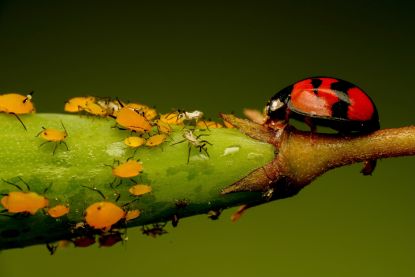Dr. Muni Muniappan works in integrated pest management. Muniappan is a prominent researcher in the field of invasive plant species and a world renowned entomologist. His work on pest management has been highly applauded globally.
Dr. Muniappan has been involved in a range of research grants, predominately aiming to manage invasive weeds and insect pests in countries most vulnerable to their threat. In 2006, he joined Virginia Tech to lead the Feed the Future Innovation Lab for Integrated Pest Management. During his last visit to Nepal in May 2022, Gobinda Prasad Pokharel talked with Dr. Muniappan about the biological invasion and pest management practices in Nepal and across the globe.

Gobinda: How do you assess the status of invasive species invasion and trends around the world?
Invasive plants have been problem for some time and have increased in spread due to the globalization of trade and the movement of people. Invasive plants and pests are getting moved around. Often, people introduce ornamental plants without knowing their invasion threat. They don’t realize the threats, as some plants often carry small insects or fungi or microorganisms. They travel with plants and get established in new countries/regions. Sometimes the plant itself is invasive.
For example, water hyacinth has nice flowers and grows well in ponds. So, from South America it got introduced to Australia to Asia and to Africa, where it forms thick mats on the water bodies and forms thickets.. The same is true for Lantana, which has beautiful flowers. People took the plant to different parts of the world. The seeds of Lantana camara (Kande Banphada) are dispersed by birds, and it is now spreading all over Asia and Africa, where it crowds out grazing and agricultural lands.
Another invasive plant is Chromolaena odorata (Seto banmara). It was introduced by the British in 1935 in the Calcutta Botanical Garden as an ornamental plant. It escaped from the garden and spread outside aggressively in south and south east Asia, particularly in the humid tropics. Its seeds were transferred from India to Ghana or Nigeria through contaminated seeds of the forest tree Gmelina arborea, and in that process, the weed was transferred to Africa.
In 2002, he was working in Guam, and a man called and said, “My papaya tree has a white coating, can you tell me what it is?” He asked him to bring the specimen, and He checked it. It was a mealybug. It was not a problem before, but in 2002 it became a problem in Guam. He sent the specimen to the Natural History Museum, London for identification, and it was found to be a new mealybug to Guam and they told him to communicate with the US Department of Agriculture( USDA). It confirmed that the mealybug was originally from Mexico, where the bug also had some parasitoids that controlled it.
In 2006, I was working at Virginia Tech and traveling to Nepal, Bangladesh, India, and Africa. In 2008, I went to India, and saw this mealybug in the southern part of the country. I knew the species was new to India and originally from Mexico, so I went to the Indian Council of Agriculture Research and told them it’s a new mealybug to India that should be managed. They listened, but did not take it seriously. In 2010, the mealybug started moving from the southern part of India to the northern part and began attacking mulberry plants, papaya, and other plants.
When the pest started attacking mulberry plants, farmers could not use insecticides because the mulberry is grown for silkworms. Thereafter, the ICAR authorities contacted me and asked for my recommendation. Parasitoids were imported from the laboratory in Puerto Rico, cultured at Bangalore, and released to control the mealybug. Now, this mealybug is present in Nepal, Pakistan, and Bangladesh, but the parasitoid also moved with it and is controlling the pest.
Gobinda: You are the first person to alert the Nepal government about the Fall Armyworm and Tuta absoluta (South American tomato leafminer), two pests causing problems in the country. What are your observations of the pests?
Tuta absoluta (common name is south American tomato leafminer) is a South American pest. It is found all over South America. It is a small moth. It was introduced to Spain by accident in 2006. The population that reached Spain was from Chile originally, and it started to spread in Europe, then it crossed the Mediterranean Sea and reached Morocco and other countries in the northern part of Africa. Then it started to spread all over Africa. In 2013, when I came to know it started to spread in Ethiopia, I took scientists from East Africa to Ethiopia and conducted an awareness workshop.
I also took scientists from Nepal and India to this workshop to create awareness about this pest. Later, we also conducted an awareness workshop in Nepal for scientists and administrators to be prepared for its management when it invades. I gave them pheromone traps so that they could set them up in their countries to monitor the pest. As soon as the pest is found in the trap they could recognize its arrival.
Gobinda: Tuta absoluta attacks tomato and fall armyworm attacks maize. You trained Nepali researchers on these pests and their management. Why do you think these pests are still a problem?
We created awareness and we’re also working with the Nepali government, so we gave all the recommendations on what should be done when these pests invade. We gave them pheromone traps to be aware of their presence and we also had a project with the University of Virginia’s Biocomplexity Institute in the USA to model the spread of these insects.
The tomato leafminer only attacks tomato. The other crops are not affected seriously. It will go to potato but the damage is minimal. The scientists who modeled the spread of this species found that tomato transportation through trucks from one city to other cities is a major cause of the spread. This pest cannot fly long distances.
I expected Tuta absoluta will come from Africa to the Middle East to Afghanistan and from Pakistan to the northern part of India. But what happened was that it came from Africa to the Middle East. Large numbers of workers from Nepal, India, Bangladesh, and Philippines work in the Middle East and they travel once a year to their native countries, inadvertently introducing the tomato leafminer to India, Nepal, and Bangladesh. It was first found near Pune in Maharashtra. In Nepal, this pest was first found in Kathmandu, not in southern Nepal. It is possible that it got introduced from India or directly from the Middle East through the workers.
Gobinda: What is the possibility of a food crisis in Nepal or South Asia?
Well, the fall armyworm attacks maize and other crops are not affected that much. Nepal has maize growing in Terai and midhills. In middle hills it is grown as food crop, and FAW could cause severe damage to the crops unless proper control measures are adopted.
Gobinda: You have taken Nepali agricultural scientists to be trained in Ethiopia, but the problem of these pests is still alarming. What is your opinion?
The problem is when an invasive pest comes in, it is not easy to come up with an immediate solution. The immediate reaction to manage these pests with the use of pesticides. There are problems with indiscriminate use of pesticides. I went to Kapilvastu during my recent field visit looking for parasitoids in the field. One of the farmers said he had sprayed the field with a pesticide the day before. I asked what kind of pesticide he used.
He said that he had the chemical at his home. He went back to his home and brought it to show me. The liquid pesticide was stored in a mountain dew bottle. He got the chemical in a discarded bottle because he couldn’t buy the whole container of the pesticide in its original labeled container. He had no label or information on the pesticide. He had no information on the toxic nature of pesticide, the amount to be used, post entry interval, or safe disposal. This leads to misuse of pesticides, resulting in adverse impacts to human and environmental health.
When a pest gets introduced to a new place, the population goes up and it will come down in the third or fourth year after its introduction, but may or may not come down below the economic threshold level. If it does not come down then we have to introduce some interventions to bring it down below the economic threshold level. So, we are currently working on exploring for introduction of interventions that are effective, safe, and sustainable.
There are scientists with different opinions. My approach is to utilize local parasitoids, or natural enemies to supress a pest. So far, we identified two egg parasitoids of fall armyworm and are planning to produce them in large numbers in Nepal. We are establishing nucleus centres at Khumaltar and in Rampur NARC laboratories, and setting up satellite centres in provinces all over Nepal. These nuclear centres produce the parasitoids and they have human and institutional resources and knowledge. They provide training to satellite centres. The satellite centres could be related to provincial or local governments, cooperatives, or private entrepreneurs.
Gobinda: Are you focusing only on biological measures?
Physical measures are employable but not effective and economical. Chemical control measures are effective but they do carry some human and environmental health risks. GMOs provide control but not all countries accept this technology. Biological control of FAW is one of the safe and sustainable methods.
Gobinda: You’ve been working in pest management in different countries. What should Nepal do in the coming future to prevent invasion of pests?
Nepal needs to get prepared for future invasive pests. The country has many researchers and research institutions working in pest management. It has Plant Quarantine and Pesticide Management Centre (PQPMC). They all need to work together to develop programs to address invasive pests. We are also working PQPMC in reviewing quarantine and pesticides regulations. Chemical pesticides that are banned or whose registration has been withdrawn in developed countries should not be used.
Gobinda: In terms of pest management, we often depend on pesticides. While you are helping to culture biological control, pesticide use is increasing. What do you think of this?
It’s a good question. The use of chemical pesticides is increasing for various reasons. There are biological pesticides or natural enemies available to control pests. Some could be produced locally in Nepal. Trichoderma, for example, is a beneficial fungus. When I went to an Indian university in 2007, they took me around the campus and showed me a plant pathology building. There, they were selling Trichoderma. I asked them to whom they sell. They said they sold to farmers and there is great demand for it. Their plant pathology building was built from the sales of Trichoderma.
Unfortunately, pesticide companies often offer initiatives to agro-vets such as if they sell a couple of pesticide containers, they get one bottle of pesticide free, or other lucrative offers.. Such tactics promote sale of chemical pesticides and there indiscriminate use.
Now, Trichoderma is a very popular biological product in Nepal’s agricultural landscape. Other companies are also interested in producing this product and some are inoculating it in compost. We are encouraging some students and other youth to produce Trichoderma in their villages either to use it in their own farms or to sell to the neighbouring farmers.
The fungal, viral and bacterial bio-agents are amenable for storage, but insect parasitoids and predators have to be used within a short time. We are actively promoting use of biopesticides in Nepal.
Gobinda: In the near future do you see the arrival of new pest species in Nepal impacting the agro-ecosystem?
There is a good possibility. There are several invasive pest species in Nepal that are yet to be identified. Recently, a professor of Tribhuvan University, Bharat Babu Shrestha, who works on invasive plant species, identified a few new invasive alien plant species in Nepal, including Mimosa diplotricha. The IPM Innovation Lab project organized pest alert programs in Jhapa, Morang districts, and Kavre districts in April 2022 with the collaboration of PQPMC and Tribhuvan University. This is the first time this type of pest alert program was conducted in Nepal. The PQPMC has a mandate to work on the invasive species. We work with research and regulatory bodies to manage invasive pest species by adopting different appropriate technologies.
Gobinda: What would you like to say to Nepali researchers?
Several improvements can be made. Research and extension could be better integrated with universities, government research institutions, and regulatory bodies to work together to address problems faced by the farmers. For example, Tribhuvan University faculty have done a lot of work on identification of invasive weeds and their impact on human and environmental health, but this work needs to be integrated with management of invasive weeds by the PQPMC and Department of Agriculture.
For the management of invasive insects, NARC, Agriculture and Forestry University, and other universities should conduct research on their identification and economic damage, and work with NGOs, value chain projects, and Department of Agriculture for management activities. They have to transfer their laboratory findings to the fields for the benefit of the farmers.
Also, read: ‘Whatever makes profit is a beat, what doesn’t, isn’t a beat in our newsrooms’– Subhra


